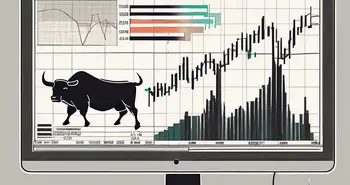The Ultimate Trading Strategy

Trading in financial markets can be a highly lucrative endeavor, but it's not without its risks. That's why having a solid trading strategy is essential for success. In this comprehensive guide, I'll walk you through everything you need to know to develop and optimize your own ultimate trading strategy.
Understanding the Basics of Trading
Before diving into the intricacies of trading strategies, it's crucial to have a solid understanding of the basics. This includes knowing how financial markets work, the different types of assets available for trading, and the factors that influence price movements. Without this knowledge, building an effective trading strategy would be like building a house on shaky ground.
Financial markets are complex ecosystems where buyers and sellers come together to trade various assets. These assets can range from stocks and bonds to commodities and currencies. Each asset class has its own unique characteristics and can be influenced by different factors. For example, the stock market is influenced by company earnings, economic indicators, and investor sentiment, while the currency market is influenced by interest rates, geopolitical events, and economic data.
Price movements in financial markets are driven by supply and demand dynamics. When there is more buying pressure than selling pressure, prices tend to rise, and when there is more selling pressure than buying pressure, prices tend to fall. Understanding these price movements and being able to predict them is key to successful trading.
The Importance of a Trading Strategy
A trading strategy is like a roadmap that guides you through the ups and downs of the market. It helps you make informed decisions and manage risk effectively. Without a strategy, you're essentially gambling with your hard-earned money. So, don't make the mistake of jumping into the market without a well-thought-out plan.
Developing a trading strategy involves analyzing various factors such as your risk tolerance, investment goals, and time horizon. It also involves studying historical price data, identifying patterns, and using technical indicators to generate trading signals. A good trading strategy should have clear entry and exit rules, as well as risk management techniques to protect your capital.
It's important to note that no trading strategy is foolproof. The market is constantly evolving, and what works today may not work tomorrow. That's why it's important to continuously monitor and adapt your strategy based on market conditions.
Key Trading Terminologies
Every industry has its own jargon, and trading is no exception. To navigate the trading world successfully, you need to familiarize yourself with key terminologies such as support and resistance levels, candlestick patterns, trendlines, and moving averages. Understanding these terms will enable you to analyze the market better and make informed trading decisions.
Support and resistance levels are price levels where buying or selling pressure is expected to be strong, causing the price to bounce back or reverse. Candlestick patterns are graphical representations of price movements that can provide insights into market sentiment. Trendlines are lines drawn on a price chart to show the direction and strength of a trend. Moving averages are indicators that smooth out price data to identify trends and potential reversals.
By understanding these key trading terminologies, you'll be able to interpret price charts, identify potential trading opportunities, and manage your risk effectively. Remember, knowledge is power in the world of trading.
Building Your Trading Strategy
Now that you have a solid foundation, it's time to start building your trading strategy. This process involves several crucial steps that will shape your approach to the markets.
Setting Your Trading Goals
Before diving into the markets, it's important to set clear and realistic trading goals. These goals will serve as your compass and provide you with a sense of direction. Whether your goal is to achieve consistent profits or build long-term wealth, defining your objectives will help you stay focused and motivated.
Choosing the Right Trading Style
There are various trading styles to choose from, including day trading, swing trading, and position trading. Each style has its own pros and cons, and it's important to consider your personality, available time, and risk tolerance when making this decision. Remember, there is no one-size-fits-all approach to trading. It's crucial to find a style that aligns with your strengths and preferences.
Risk Management in Trading
One of the key pillars of a successful trading strategy is effective risk management. This involves setting clear stop-loss levels, determining the appropriate position size for each trade, and diversifying your portfolio. By implementing sound risk management principles, you'll be able to protect your capital and minimize potential losses.
Essential Components of a Successful Trading Strategy
Now that you have a solid plan in place, let's explore some essential components that will further enhance the effectiveness of your trading strategy.
Technical Analysis for Trading
Technical analysis involves analyzing historical price data and identifying patterns and trends. By studying charts and utilizing various indicators, you can gain insights into market sentiment and make more accurate predictions. Technical analysis is an essential skill for any trader looking to maximize their profits.
Fundamental Analysis for Trading
In addition to technical analysis, fundamental analysis plays a crucial role in trading. This involves assessing the underlying value of an asset by analyzing economic indicators, company earnings reports, and industry trends. By understanding the fundamental factors driving price movements, you can make more informed trading decisions.
Sentiment Analysis for Trading
Market sentiment refers to the overall attitude and emotions of traders towards a particular asset or market. By gauging sentiment through various tools and indicators, you can identify potential market reversals or excessive optimism/pessimism. Knowing when to go against the crowd can be a powerful strategy for profiting in the market.
Optimizing Your Trading Strategy
Once you have a trading strategy in place, your work is far from over. To stay ahead of the curve, it's crucial to continuously optimize your strategy based on market conditions and performance.
The Role of Backtesting
Backtesting involves analyzing historical data to assess the effectiveness of your strategy. By simulating trades based on past market conditions, you can identify strengths and weaknesses in your approach. This allows you to refine and fine-tune your strategy for better results in the future.
Importance of Consistent Review and Adjustment
Markets are dynamic, and what works today may not work tomorrow. That's why it's important to consistently review and adjust your trading strategy. Stay up to date with the latest news and developments, evaluate the performance of your trades regularly, and make the necessary adjustments to adapt to changing market conditions.
Common Pitfalls in Trading and How to Avoid Them
Even the most experienced traders fall into common pitfalls from time to time. Understanding these pitfalls can help you steer clear of them and improve your trading performance.
Overtrading and How to Avoid It
Overtrading is a common mistake among traders. It occurs when you excessively trade based on emotions rather than sound analysis. To avoid overtrading, it's important to stick to your trading plan, exercise discipline, and avoid impulsive decisions.
Emotional Trading and Its Impact
Emotions can cloud judgment and lead to poor decision-making in trading. Fear and greed are two powerful emotions that can cause traders to make irrational choices. By learning to control your emotions and sticking to your trading strategy, you can overcome this common pitfall and achieve consistent results.
In conclusion, developing a trading strategy is a crucial step towards achieving success in the financial markets. By understanding the basics, setting clear goals, and implementing effective risk management, you'll be well on your way to becoming a profitable trader. Remember, trading is a continuous learning process, so stay curious, stay disciplined, and always strive to improve your skills. Happy trading!
Ready to put your ultimate trading strategy into action? Discover the innovative world of Morpher.com, where trading meets the transformative power of blockchain technology. With zero fees, infinite liquidity, and the ability to invest fractionally or short sell across diverse markets, Morpher is the perfect platform to elevate your trading experience. Embrace the safety and control of a non-custodial wallet, leverage your trades up to 10x, and step into a unique trading realm with Virtual Futures. Sign Up and Get Your Free Sign Up Bonus today to start trading on a platform that's as forward-thinking as your strategy. Happy trading on Morpher!

Disclaimer: All investments involve risk, and the past performance of a security, industry, sector, market, financial product, trading strategy, or individual’s trading does not guarantee future results or returns. Investors are fully responsible for any investment decisions they make. Such decisions should be based solely on an evaluation of their financial circumstances, investment objectives, risk tolerance, and liquidity needs. This post does not constitute investment advice.

Painless trading for everyone
Hundreds of markets all in one place - Apple, Bitcoin, Gold, Watches, NFTs, Sneakers and so much more.

Painless trading for everyone
Hundreds of markets all in one place - Apple, Bitcoin, Gold, Watches, NFTs, Sneakers and so much more.









